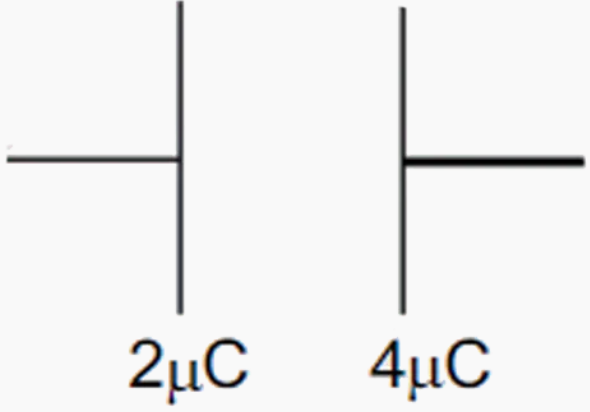Consider a parallel plate capacitor originally with a charge q0 capacitance C0 and potential difference ΔV0 There is an electrostatic force of magnitude F0 between the plates and the capacitor has a stored energy U0. The terminals of the capacitor are connected to another capacitor of same capacitance and charge.
A dielectric slab with ke>1 is inserted between the plates of the first capacitor . Which quantity decreases?
q
C
ΔV
F
The correct Answer is:C
To solve the problem, we will analyze the effect of inserting a dielectric slab into a parallel plate capacitor that is connected to another capacitor of the same capacitance and charge.
1. Understanding the Initial Conditions:
- We have a parallel plate capacitor with initial charge q0, capacitance C0, and potential difference ΔV0.
- The electrostatic force between the plates is F0, and the stored energy is U0.
2. Connecting Another Capacitor:
- The terminals of the first capacitor are connected to another capacitor of the same capacitance C0 and charge q0.
- When two capacitors are connected in parallel, the total capacitance becomes Ctotal=C0+C0=2C0.
- The total charge Q remains the same, but the voltage across the combined system will change.
3. Inserting the Dielectric Slab:
- When a dielectric slab with dielectric constant ke>1 is inserted into the first capacitor, the capacitance of the first capacitor increases.
- The new capacitance C′ of the first capacitor becomes C′=keC0.
4. Effect on Voltage:
- The relationship between charge, capacitance, and voltage is given by Q=CΔV.
- Since the charge q0 remains constant, we can write:
q0=C′ΔV′(after inserting the dielectric)
- Substituting C′:
q0=keC0ΔV′
- Rearranging gives:
ΔV′=q0keC0
- Since ke>1, it follows that ΔV′<ΔV0. Thus, the potential difference decreases.
5. Conclusion:
- The quantity that decreases when the dielectric slab is inserted is the potential difference ΔV.
Final Answer:
The potential difference ΔV decreases.
- We have a parallel plate capacitor with initial charge q0, capacitance C0, and potential difference ΔV0.
- The electrostatic force between the plates is F0, and the stored energy is U0.
- The terminals of the first capacitor are connected to another capacitor of the same capacitance C0 and charge q0.
- When two capacitors are connected in parallel, the total capacitance becomes Ctotal=C0+C0=2C0.
- The total charge Q remains the same, but the voltage across the combined system will change.
- When a dielectric slab with dielectric constant ke>1 is inserted into the first capacitor, the capacitance of the first capacitor increases.
- The new capacitance C′ of the first capacitor becomes C′=keC0.
- The relationship between charge, capacitance, and voltage is given by Q=CΔV.
- Since the charge q0 remains constant, we can write:
q0=C′ΔV′(after inserting the dielectric)
- Substituting C′:
q0=keC0ΔV′
- Rearranging gives:
ΔV′=q0keC0
- Since ke>1, it follows that ΔV′<ΔV0. Thus, the potential difference decreases.
- The quantity that decreases when the dielectric slab is inserted is the potential difference ΔV.
The potential difference ΔV decreases.
Topper's Solved these Questions
- CAPACITANCEBook:RESNICK AND HALLIDAYChapter:CAPACITANCEExercise:PRACTICE QUESTION MATRIX MATCH
Explore 8 Videos
- CAPACITANCEBook:RESNICK AND HALLIDAYChapter:CAPACITANCEExercise:PRACTICE QUESTION (INTEGER TYPE)
Explore 3 Videos
- CAPACITANCEBook:RESNICK AND HALLIDAYChapter:CAPACITANCEExercise:PRACTICE QUESTIONS (MORE THAN ONE CORRECT CHOICE TYPE)
Explore 12 Videos
- ALL ABOUT ATOMS Book:RESNICK AND HALLIDAYChapter:ALL ABOUT ATOMS Exercise:CHECKPOINT
Explore 1 Video
- CENTER OF MASS Book:RESNICK AND HALLIDAYChapter:CENTER OF MASS Exercise:Practice Questions (Integer )
Explore 4 Videos
Similar Questions
The plates of parallel capaitor are given charges +4Q and −2Q. The capacitor is then connected across an uncharged capacitor of same capacitances first one (=C). Find the final potential difference between the plates of the first capacitor.
View SolutionParallel Plate Capacitor |Energy Stored In A Charged Capacitor
View Solution
Knowledge Check
Consider a parallel plate capacitor originally with a charge q0 capacitance C0 and potential difference ΔV0 There is an electrostatic force of magnitude F0 between the plates and the capacitor has a stored energy U0. The terminals of the capacitor are connected to another capacitor of same capacitance and charge.
Later the dielectric slab is removed. WHile the slab is being removed.ACharge on second capacitor increasesBCharge on second capacitor decreasesCCharge on second capacitor is constantDCan't be saidConsider a parallel plate capacitor originally with a charge q0 capacitance C0 and potential difference ΔV0 There is an electrostatic force of magnitude F0 between the plates and the capacitor has a stored energy U0. The terminals of the capacitor are connected to another capacitor of same capacitance and charge.
What is the direction of the electrostatic force on the dielectric slab while it is being increased?AThe force pulls the slab into the capacitorBThe force pushes the slab out of the capacitorCThere is no electrostatic force of the slabDCan't be saidA dielectric slab is placed between the plates of a parallel plate capacitor. Its capacitance
Abecomes zeroBremains the sameCdecreasesDincreases
There is an air capacitor with capacitance C, charged to a potential difference of V. If the capacitor is isolated from the battery after charging, and then a dielectric slab is inserted in between the plates of capacitor. How will the energy stored in this capacitor change?
View SolutionWhat is a parallel plate capacitor? Obtain an expression for the capacitance of a parallel plate capacitor when a conducting slab is inserted between its plates.
View SolutionIn a parallel plate capacitor, the distance between the plates is d and potential difference across the plate is V. Energy stored per unit volume between the plates of capacitor is
View SolutionA parallel plate capacitor is charged by connecting is plates to the terminals of a battery. The battery remains connected to the condenser plates and a glass plate is interposed between the plates of the capacitor, then
View SolutionIn a parallel plate capacitor of capacitor 1μF two plates are given charges 2μC and 4μC the potential difference between the plates of the capacitor is

View Solution

